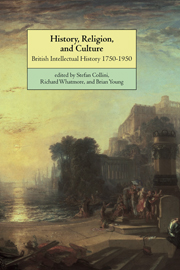Book contents
- Frontmatter
- Contents
- Preface
- General introduction
- Presentation of History, Religion, and Culture
- Part I
- Part II
- 4 ‘The Lust of Empire and Religious Hate’: Christianity, history, and India, 1790–1820
- 5 The Victorians and Oliver Cromwell
- 6 Religion and politics in the Quarterly Review, 1809–1853
- 7 Ruskin's way: tout à fait comme un oiseau
- Part III
- List of contributors
- Acknowledgements
- Index
7 - Ruskin's way: tout à fait comme un oiseau
Published online by Cambridge University Press: 03 December 2009
- Frontmatter
- Contents
- Preface
- General introduction
- Presentation of History, Religion, and Culture
- Part I
- Part II
- 4 ‘The Lust of Empire and Religious Hate’: Christianity, history, and India, 1790–1820
- 5 The Victorians and Oliver Cromwell
- 6 Religion and politics in the Quarterly Review, 1809–1853
- 7 Ruskin's way: tout à fait comme un oiseau
- Part III
- List of contributors
- Acknowledgements
- Index
Summary
After Mr Ruskin took his leave, Gambart asked her [the painter Rosa Bonheur's] opinion about him. ‘He is a gentleman’, she said, ‘an educated gentleman; but he is a theorist. He sees nature with a little eye – tout à fait comme un oiseau.’
Ruskin is weak on mass. This was pointed out to me by John Burrow on a Ruskinian enough occasion: a walk around Christ Church Meadow in Oxford. Behind us was the Meadow Building of 1862–7. Critics of it seem always to say two things about it: that it is Ruskinian and that they do not like it. There is no record in Christ Church of Ruskin's participation in its design. It went up in the reign of Ruskin's friend, Dean Liddell, who may well have taken any correspondence about it away with him when he retired – and such papers seem mainly to have vanished. Liddell was a great admirer of Modern Painters and The Stones of Venice, a capable amateur draughtsman, and a tireless builder. They fell out later, when Ruskin was Slade Professor, but in the 1860s they were getting on well enough and Thomas Deane was the chosen architect. He was the son of the surviving partner in business of Benjamin Woodward, universally loved and admired, with whom Ruskin had worked on the University Museum. Woodward died in 1861. Ruskin had insisted, during work on the museum, that one partner in the firm of Woodward and Deane was as good as another, but perhaps betrayed his real preference by getting Deane's Christian name wrong. It is a preference which is likely to be shared by anyone comparing the museum with Meadow Building.
- Type
- Chapter
- Information
- History, Religion, and CultureBritish Intellectual History 1750–1950, pp. 156 - 176Publisher: Cambridge University PressPrint publication year: 2000
- 1
- Cited by



